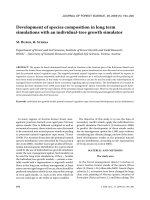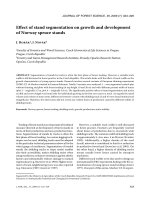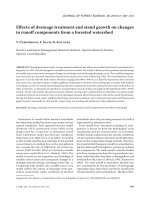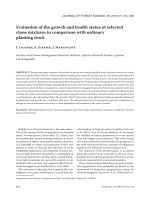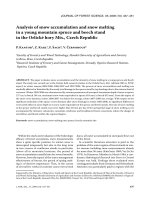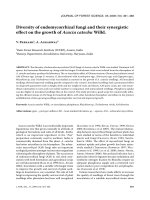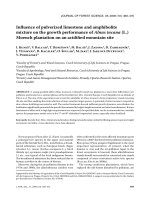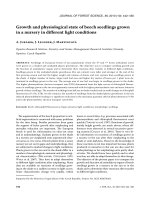Báo cáo lâm nghiệp: " Growth of wild cherry (Prunus avium L.) in a mixture with other species in a demonstration forest" ppsx
Bạn đang xem bản rút gọn của tài liệu. Xem và tải ngay bản đầy đủ của tài liệu tại đây (213.41 KB, 6 trang )
264 J. FOR. SCI., 55, 2009 (6): 264–269
JOURNAL OF FOREST SCIENCE, 55, 2009 (6): 264–269
Actual silvicultural and management regimes
should ensure the sustainability of forest ecosystems
in terms of production, their diversity and other
goals expected by modern society. Species which
fulfil these goals are in focus of modern silviculture.
One of these species is wild cherry (Prunus avium L.)
and that is why it is also a subject of research.
The wild cherry has its optimum in the first to
the fourth (fifth) forest vegetation zone (Č,
B 1999; Š, Š
2005) in a rich and floodplain forest. It shows the
best growth performance on fresh, nutritious,
loamy and calcareous soils (Š 1997).
However, even at calcareous-poor, moderately
acidic and drier sites wild cherry still has good
growth performance (V 1965; F 1982;
S 1994). Generally wild cherry develops
a heart-shaped root system and far reaching lat-
eral roots in top soil horizons. In easily rootable
soils the root system reaches down to depths of
about 3 m (
E et al. 1998). However, under
unfavourable conditions such as shallow soils the
root system is concentrated on upper soil layers.
Under natural conditions wild cherry occurs at
sites where the competition strength of European
beech decreases as a consequence of less favour-
able water supply. Hence the natural niche of wild
cherry at dry sites is not a result of optimal growing
conditions; it is a result of competition (E
et al. 1998).
e wild cherry reaches maturity quite early at the
age of 20 to 25 years. Its growth is fast till 40 years
and expected senescence is about 80 to 90 years with
breast height diameter of 50 cm and more and height
of 20 to 30 m.
Most authors recommend for wild cherry to be
grown in a mixture with other species or as an as-
sociated species only (Č, B 1999).
Several authors have reported its superior height
growth over Fagus sylvatica (B 1977; W,
R 1993; O, B 2000), Sorbus tormi-
nalis (S, B 1996) or other broadleaves
such as Quercus robur, Quercus petraea, Tilia sp.
and Carpinus betulus (P 2007).
Growth of wild cherry (Prunus avium L.) in a mixture
with other species in a demonstration forest
R. S, I. K
Faculty of Forestry and Wood Sciences, Czech University of Life Sciences in Prague, Prague,
Czech Republic
ABSTRACT: Wild cherry is one of the noble hardwood species that increase the biodiversity of our forests and at
the same time it could increase the income for forest owners. e preconditions for achieving these goals are the high
quality of stem and appropriate silvicultural management. is means that wild cherry should occupy the main crown
layer in the stand. e height/frequency diagram depicts two groups of wild cherry trees in the stand belonging to
dominant/codominant and suppressed tree classes. Height periodic increment (measured between the years 2001 and
2007) is significantly (p < 0.01) different in these two groups confirming that there is no transition chance for the trees
from the suppressed group to become a part of the main crown layer and play the role of future crop tree. e same
is true of the diameter/frequency diagram which also has a two-peak shape remaining also at the end of the surveyed
period. Our result suggests that silvicultural care should be focused only on trees belonging to future crop trees.
Keywords: wild cherry; silviculture; stand forming species; stand crown layer; tree classes
J. FOR. SCI., 55, 2009 (6): 264–269 265
e growth rate of wild cherry is similar to other
fast growing broadleaves such as Acer pseudopla-
tanus, Acer platanoides, Fraxinus excelsior (L-
1988; R et al. 1999; P 2007). However,
despite of its fast initial height growth the wild cherry
appears to be a weak competitor towards other tree
species and might rapidly be suppressed as soon as
it is overtopped by its neighbours (R et al. 1999;
G et al. 2002; P 2007). It seems that the
wild cherry breeding program could influence the
growth and vitality very efficiently (K 2002;
H et al. 2007).
The wild cherry as a light-demanding species
reacts to competition sensitively. Lateral crown
shading causes a dieback of branches. Thus the
competition of neighbouring trees must be regu-
lated. is ensures high diameter growth and quality
development. Since shade-tolerant tree species are
highly competitive with wild cherry, mixtures with
such species should be observed with special care.
On the other hand, a mixture with species of
similar growth patterns is strongly recommended.
P (1996) recommended for a mixture the fol-
lowing species: sycamore, ash, lime, alder, elm and
oak and as conifers larch, spruce, fir and Douglas fir.
Especially mixtures with other valuable broadleaved
species such as common ash (Fraxinus excelsior) or
sycamore maple (Acer pseudoplatanus) are particu-
larly suitable (S 1994). ese species show
comparable growth dynamics in the first 25 years.
S (1994) did not recommend pure wild
cherry stands due to forest health reasons. To reduce
the competition the planting of trees in small groups
of single species is recommended. e minimum size
of these groups is defined by the expected crown di-
ameter at the end of production period. Silvicultural
interventions are minimized in this manner. Possible
admixtures are also rows along stand borders, forest
roads or small pure patches in gaps.
A single tree mixture with or under European larch
might be another option (S 1994). Both tree
species fit together with their demand on light and
their height growth dynamics. Larch will become
older and thus can be managed as hold-on trees
(S 1994). e mixture with oak is a further
option. In oak stands open space between dominant
trees or gaps resulting from removing trees of minor
quality can often be filled by the fast growing wild
cherry (S 1994).
ere is not much knowledge of silviculture of wild
cherry as a stand-forming species as the species is now
rather rare (S 1994; E et al. 1998).
e purpose of the contribution is to evaluate the
stand-forming capacity of wild cherry as well as its
capacity to keep its position in a stand.
MATERIAL AND METHODS
A large stand with wild cherry trees as a stand-
forming species in the area of Demonstration Forests
in Kostelec nad Černými lesy in the mixture with
other species was found. e stand 39A5 is located
at 49°57'28''N latitude and 14°49'20''E longitude.
e total number of 16 circular sample plots was
chosen, systematically placed in the stand, each of
them 100 m
2
. e tree inventory and all necessary
measurements were done in 2001 and 2007. e
measurements and calculation include breast-height
diameter (to the nearest 5 mm), tree height (to the
nearest 0.5 m), size of the crown (vertically and
horizontally) and tree class evaluation (according to
Konšel’s classification).
e stand is at an altitude of about 350 m above sea
level; its age is 59 years now. e stand grows at a rich
site (labelled 3B3 in the Czech typological system) on
a slight slope of south-west exposition.
Slenderness quotient was calculated as the ratio of
total height to breast height diameter for each tree.
Table 1. e average stem data for species on sample plots
Species
dbh
2001
(cm)
Height
2001
(m)
BA
2001
(cm
2
)
Share of
species 2001
(%)
dbh
2007
(cm)
Height
2007
(m)
BA
2007
(cm
2
)
Share of
species 2007
(%)
Wild cherry 24.5 21.2 505.2 15.7 25.8 22.4 564.0 14.4
Lime 18.6 18.6 301.4 9.3 21.0 20.4 387.9 9.9
Larch 24.0 24.9 473.8 14.7 27.1 27.8 605.5 15.5
Aspen 31.5 22.8 827.9 25.7 35.7 24.6 1,077.4 27.6
Pine 27.6 25.2 598.2 18.5 30.2 25.7 719.0 18.4
Spruce 20.8 20.1 356.0 11.0 21.9 22.4 395.7 10.1
Alder 14.4 17.0 162.8 5.0 14.3 14.2 159.4 4.1
266 J. FOR. SCI., 55, 2009 (6): 264–269
Crown size and its diameter as an average of diam-
eters of north-south and east-west directions were
also measured to the nearest 0.1 m.
e stand is under a normal silvicultural regime,
i.e. after the last thinning carried out in the ninetieth.
After that there have been only sanitary cuttings.
RESULTS AND DISCUSSION
e share of wild cherry on sample plots varies
from 10 to 58%. e other species on the plots are
aspen, pine, larch, spruce, lime and alder (in ac-
cordance with their share of BA). Basic data on the
stand species composition and mean stem are given
in Table 1.
Average stand height is about 21 m, which is
reached by stand-forming species, i.e. aspen (26%),
pine (18%), larch (15%) and wild cherry (15%). e
other species are admixtures with small proportions
in stand basal area.
e paper is focused on detailed analysis of wild
cherry trees, their growth dynamics and capability
to keep their position as a stand-forming species.
As a light-demanding species wild cherry crop trees
need not be overtopped by the other species. e
height periodic increment for the surveyed period
(2001–2007) is 1.9 m. ere are significant differ-
ences in height increment between dominant and
co-dominant trees (2.4 m) while the height periodic
increment of suppressed trees is only 0.7 m (highly
significant differences, p < 0.01). It means that differ-
ences between these two crown layers (tree classes)
are not only maintained but also they become more
pronounced in the surveyed period. e situation is
illustrated in Fig. 1.
One can see that with one exception (where the
periodic increment of suppressed tree reaches nearly
3 m) the periodic increment of suppressed trees is
significantly lower than the average periodic incre-
ment of dominant and codominant trees. is is true
of trees with the same dbh (about 20 cm). e data
confirm that once the light-demanding species lost
their position in the main crown layer, they never get
back (S 1994). It also means that suppressed
trees could only play the role of “help and clean posi-
tion” in the stand and they cannot be considered as
future crop trees from a silvicultural point of view.
e height development of the stand is illustrated
in Fig. 2, where a shift (height increment) is clearly
visible in the height/frequency diagram.
Both height/frequency curves have two peaks
revealing that two crown layers are conserved in the
vertical structure of the stand. e diagram shows
that development of stands conserves their structure
0
1
2
3
4
5
6
7
8
9
10 15 20 25 30
Tree height (m)
H increment (m)
dominant trees suppressed trees
0
5
10
15
20
7 12 17 22 27 32 37
Height (m)
Frequency
2001 2007
Fig. 1. Periodic height increment for
dominant (including codominant) and
suppressed trees of wild cherry
Fig. 2. Height/frequency diagram of the
wild cherry stand (starting age 53 years)
in the time period of 6 years
J. FOR. SCI., 55, 2009 (6): 264–269 267
and confirms that there is no “transition” between
the future crop tree and suppressed tree layer.
A similar situation can be observed in diameter
analysis. e trees that do not belong to dominant/
codominant trees have statistically significantly
lower (p < 0.01) dbh increments. e situation is
illustrated in Fig. 3.
Periodic dbh increment (for the years 2001–2007)
as an average for all measured trees was 1.2 cm, i.e.
annual increment was 2 mm, which is slightly be-
hind the expectation (S 1994), but again the
figure is an average for all wild cherry trees. While
dominant and codominant trees have the periodic
increment of 1.6 cm for the same time period, the
suppressed trees have only 0.35 cm. e differences
are statistically highly significant. e differences
are clearly visible in Fig. 3, where also linear trends
are given. Trees with nearly the same dbh – but
belonging to dominant/codominant trees – have
significantly higher diameter increment that those
belonging to suppressed trees.
e diameter/frequency diagram shows the di-
ameter structure at the beginning and the end of
surveyed period (see Fig. 4).
e existence of two layers within the stand is also
visible from the diameter structure. Both curves have
the same shape depicting a two-layer structure.
Some silviculturists recommend to conserve wild
cherry only in the main layer as target trees (S
1994). Recommended target trees/ha are in that way
only 51, which is less than one target tree per our
sample plots (100 m
2
), supposing that the crown
diameter will be about 10 m. Our stand situation is
clearly quite different (more than 5 wild cherry trees
per plot with the crown diameter less than 5 m),
which could explain lower diameter increment.
Finally the slenderness quotient (the ratio of height
to dbh) was evaluated for each tree class (Konšel).
e results are given in Table 2.
The slenderness quotients of wild cherry trees
according to their diameters are clearly different
for trees with small diameter and trees with large
diameter. e slenderness quotient development in
the studied period shows quite a stable situation in
the codominant (main) layer while trees belonging to
class 3 have slimmer stems. However, data indicate
that a silvicultural intervention also in the main layer
is needed in the nearest future as the slenderness quo-
tient has slightly increased for the surveyed period.
is is in correspondence with S’s (1994)
proposal of low density of wild cherry target trees.
Basically the same picture is given by crown diam-
eters according to tree classes. While dominant and
codominant trees have the crown size corresponding
0
1
2
3
4
5
5 15 25 35 45
DBH (cm)
D increment (cm)
dominant trees suppressed trees
0
5
10
15
20
25
0 10 20 30 40 50 60
dbh (cm)
Frequency
N2001 N2007
Fig. 3. Diameter increment of dominant
and codominant trees and suppressed
trees (Konšel tree classes lower than 2)
Fig. 4. Diameter/frequency diagram
for the wild cherry stand (starting age
53 years) revealing two peaks in the dia-
meter structure
dbh
0
1
2
3
4
5
5 15 25 35 45
DBH (cm)
D increment (cm)
dominant trees suppressed trees
regression line
for dominant
trees
268 J. FOR. SCI., 55, 2009 (6): 264–269
to their position, the suppressed trees have crowns
of the too small size which is significantly smaller
(see Table 3). e crown development during the
surveyed period suggests that the competition is
growing and the thinning that will bring the larger
growing space is needed immediately.
CONCLUSION
Wild cherry trees are growing mostly as admixed
and/or scattered trees in our forest stand. However,
there are some stands where the wild cherry is a
stand-forming species. e silvicultural measures
recommended for these stands are not very common
and/or very general ones and therefore the detailed
analysis of its growing capacity and required crown
space was done.
Our data suggests that the wild cherry could be
used as a stand-forming species and auxiliary (help
and clean position) species at the same time. e
height/frequency curve depicts two layers (two
groups belonging to dominant/codominant tree
classes and suppressed tree classes) of wild cherry
trees in the stand. e height periodic increments
for these two groups are statistically significantly
different (p < 0.01) confirming that there is no tran-
sition between these two groups, i.e. suppressed
trees probably never reach the future crop tree
group. e practical meaning of the finding is that
silvicultural operations should not be focused on
these losers. e same is true of the diameter/fre-
quency curve which basically has the same shape
with two peaks depicting two layers of wild cherry
trees in the stand.
e vertical and horizontal structure analysis also
shows that in middle aged stands wild cherry trees
which are still vital could be suppressed. eir qual-
ity is low but they fulfil their auxiliary role in stands
and therefore they could be kept in the stand for the
nearest future.
e slenderness quotient has an increasing ten-
dency suggesting that stronger silvicultural inter-
ventions will be needed in the stand in the nearest
future. e same conclusion could be drawn from
data on the crown size (see Table 3).
Ref erences
BACK O.A., 1977. Die Vogelkirsche (Prunus avium L.). Ein
Beitrag zur Ökologie und wirtschaftlichen Bedeutung.
Forstarchiv, 48: 154–158.
ČÍŽKOVÁ L., BENDÍKOVÁ M., 1999. Záchrana genofondu
vybraných lesních dřevin v přírodních lesních oblastech
Jihomoravských úvalů a Moravských Karpat. [Závěrečná
zpráva.] Uherské Hradiště, VÚLHM: 155.
ERLBECK R., HASEDER I.E., STINGLWAGNER G.K.F., 1998.
Das Kosmos Wald- und Forstlexikon. Stuttgart, Franckh-
Kosmos Verlags-GmbH & Co.: 890.
FLEDER W., 1982. Die Waldkirsche (Prunus avium). In: Bäu-
me und Wälder in Bayern. Bayrischer Forstverein (Hrsg.).
Pfaffenhofen, W. Ludwig Verlag: 572–576.
GAVALAND A., GAUVIN J., MOREAU A., BOUVAREL L.,
2002. De l’intérêt de planter le merisier avec un accompag-
nement d’aulne: les enseignements de trois essais INRA.
Revue Forestière Française, 54: 143–160.
HAJNALA M., LSTIBŮREK M., KOBLIHA J., 2007. First
evaluation of growth parameters in clonal test with wild
cherry. Journal of Forest Science, 53: 57–65.
KOBLIHA J., 2002. Wild cherry (Prunus avium L.) breeding
program aimed at the use of this tree in the Czech forestry.
Journal of Forest Science, 48: 202–218.
LÜDEMANN G., 1988. Anbauerfahrungen mit der Vogel-
kirsche in Ostholstein. Allgemeine Forstzeitschrift, 43:
535–537.
OBAL K.H., BARTSCH N., 2000. Anwuchs und Jugend-
wachstum der Vogelkirsche unter Schirm. Forst und Holz,
55: 616–621.
PARIS E., 2007. Les travaux en phase de qualification en
hêtraie mélangée de plateau calcaire. [Thesis.] Nancy,
ENGREF: 185.
PRUDIČ Z., 1996. Nové poznatky o pěstování třešně ptačí.
Lesnická práce, 75: 158–159.
Table 2. Slenderness quotient of wild cherry trees
according to their tree classes
Tree class (Konšel) 2001 2007
2a 84.0
a
86.2
a
2b 105.3
b
104.7
b
3 95.7
c
100.6
b
4 83.4
a
72.8
a
Average 90.0
a
91.5
a
e same letter denotes insignificant differences (p = 0.01)
Table 3. Average crown diameter according to their tree
classes
Tree class (Konšel) 2001 2007
2a 5.3
a
5.1
a
2b 4.9
a
4.8
a
3 2.9
b
2.5
b
4 2.5
b
2.5
b
e same letter denotes insignificant differences (p = 0.01)
J. FOR. SCI., 55, 2009 (6): 264–269 269
REIF A., JOLITZ T., MUNCH D., BUCKING W., 1999. Suk-
zession vom Eichen-Hainbuchen-Wald zum Ahorn-Wald.
Prozesse der Naturverjüngung im Bannwald ‘Bechtaler
Wald’ bei Kenzingen, Südbaden. Allgemeine Forst- und
Jagdzeitung, 170: 67–74.
SCHÜTE G., BECK O.A., 1996. Entwicklung einer Verjüngung
mit Elsbeere und Kirsche von 1976–1995. Forst und Holz,
51: 627–628.
SPIECKER M., 1994. Wachstum und Erziehung wertvoller
Waldkirschen. Mitteilungen der FVA Baden-Württemberg:
181.
ŠKVARENINOVÁ J., 1997. Premenlivosť kvality populácií
čerešne vtáčej (Cerasus avium (L.) Moench.) a jej vertikálne
rozšírenie v niektorých oblastiach Slovenska. Acta Facultatis
Forestalis Zvolen, 39: 21–31.
ŠKVARENINOVÁ J., ŠKVARENINA J., 2005. Bioklimatická
charakteristika vybraných pestovateľských lokalít čerešne
vtáčej (Cerasus avium L. Moench.) na Slovensku. Acta
Horticulturae et Regiotecturae, 8: 9–12.
VÁVRA M., 1965. Pěstování a zužitkování švestek a třešní.
Praha, SZN: 176.
WILHELM G.J., RAFFEL D., 1993. La sylviculture du mélange
temporaire hêtre-merisier sur le plateau lorrain. Revue
Forestière Française, 45: 66–68.
Received for publication July 27, 2008
Accepted after corrections October 27, 2008
Corresponding author:
Ing. R S, Česká zemědělská univerzita v Praze, Fakulta lesnická a dřevařská, 165 21 Praha 6-Suchdol,
Česká republika
tel.: + 420 224 383 791, fax: + 420 234 381 860, e-mail: stojecova@fld.czu.cz
Růst třešně ptačí (Prunus avium L.) ve směsi s jinými dřevinami na území
Školního lesního podniku ČZU
ABSTRAKT: Třešeň ptačí je dřevinou, kterou počítáme mezi cenné listnáče; může významným způsobem zvy-
šovat nejen biodiverzitu našich lesů, ale může znamenat i významný ekonomický přínos. Podmínkou pro splnění
těchto cílů je dostatečná kvalita kmene, které lze dosáhnout, pokud ji udržíme v hlavní porostní úrovni. Frekvenční
diagram výšek třešní v analyzovaném porostu ukazuje, že třešně tvoří dvě výškové skupiny, z nichž jedna patří
k nadúrovňovým a úrovňovým stromům, zatímco druhá skupina patří do skupiny stromů potlačených. Výškový perio-
dický přírůst (zjištěný během sledovaného období 2001–2007) těchto dvou skupin je statisticky vysoce významný
(p < 0,01). Zjištěné výsledky ukazují, že mezi těmito dvěma porostními složkami neexistuje možnost (schopnost)
přesunu z potlačené skupiny stromů do úrovně. Nelze tedy počítat s tím, že by potlačený strom mohl být zařazen
mezi cílové stromy. Podobný obrázek dostaneme při analýze tloušťkové struktury porostu. Zjištěné výsledky ukazují
na to, že pěstitelská péče musí být zaměřena zejména na stromy hlavní úrovně, resp. cílové stromy. Naše výsledky
rovněž potvrzují slabou kompetiční schopnost třešně ptačí a z ní vyplývající nutnost intenzivního a pravidelného
uvolňování koruny úrovňových třešní tak, aby nedocházelo k odumírání laterálních větví v koruně.
Klíčová slova: třešeň ptačí; pěstování lesa; porostotvorná dřevina; korunová vrstva porostu; stromové třídy

